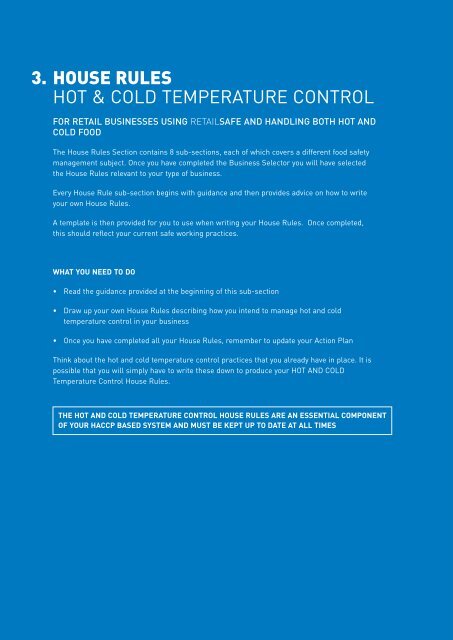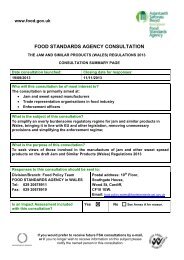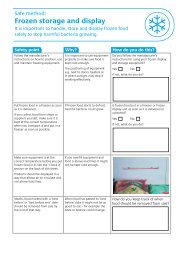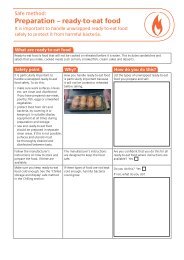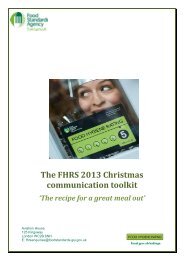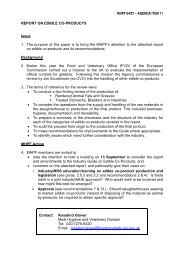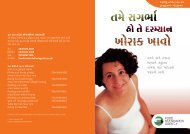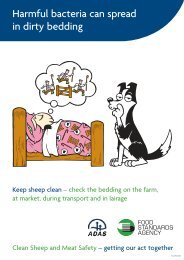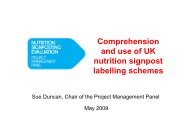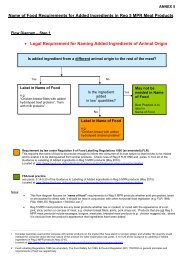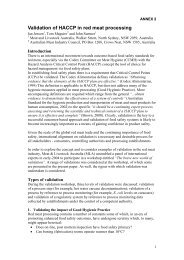3. HOUSE RULES HOT & COLD TEMPERATURE CONTROL
3. HOUSE RULES HOT & COLD TEMPERATURE CONTROL
3. HOUSE RULES HOT & COLD TEMPERATURE CONTROL
You also want an ePaper? Increase the reach of your titles
YUMPU automatically turns print PDFs into web optimized ePapers that Google loves.
<strong>3.</strong> <strong>HOUSE</strong> <strong>RULES</strong><br />
<strong>HOT</strong> & <strong>COLD</strong> <strong>TEMPERATURE</strong> <strong>CONTROL</strong><br />
FOR RETAIL BUSINESSES USING RETAILSAFE AND HANDLING BOTH <strong>HOT</strong> AND<br />
<strong>COLD</strong> FOOD<br />
The House Rules Section contains 8 sub-sections, each of which covers a different food safety<br />
management subject. Once you have completed the Business Selector you will have selected<br />
the House Rules relevant to your type of business.<br />
Every House Rule sub-section begins with guidance and then provides advice on how to write<br />
your own House Rules.<br />
A template is then provided for you to use when writing your House Rules. Once completed,<br />
this should reflect your current safe working practices.<br />
WHAT YOU NEED TO DO<br />
• Read the guidance provided at the beginning of this sub-section<br />
• Draw up your own House Rules describing how you intend to manage hot and cold<br />
temperature control in your business<br />
• Once you have completed all your House Rules, remember to update your Action Plan<br />
Think about the hot and cold temperature control practices that you already have in place. It is<br />
possible that you will simply have to write these down to produce your <strong>HOT</strong> AND <strong>COLD</strong><br />
Temperature Control House Rules.<br />
THE <strong>HOT</strong> AND <strong>COLD</strong> <strong>TEMPERATURE</strong> <strong>CONTROL</strong> <strong>HOUSE</strong> <strong>RULES</strong> ARE AN ESSENTIAL COMPONENT<br />
OF YOUR HACCP BASED SYSTEM AND MUST BE KEPT UP TO DATE AT ALL TIMES
<strong>HOUSE</strong> <strong>RULES</strong> <strong>HOT</strong> & <strong>COLD</strong> <strong>TEMPERATURE</strong> <strong>CONTROL</strong> <strong>3.</strong>12<br />
This sub-section will give guidance on Temperature Control and is intended for businesses that<br />
handle both <strong>HOT</strong> AND <strong>COLD</strong> food. At the end of the sub-section you will be asked to write your<br />
own House Rules to show how you manage <strong>HOT</strong> AND <strong>COLD</strong> temperature control in your business<br />
HAZARDS (What can go wrong)<br />
• Microbiological Contamination - Harmful bacteria are a hazard present in many of the foods<br />
handled in retail businesses. If these bacteria are not controlled they may multiply to<br />
dangerous levels and cause food poisoning.<br />
<strong>CONTROL</strong>S (How you can prevent the hazard)<br />
Bacteria are invisible to the naked eye and cannot be physically removed from food. All we can do<br />
is control their numbers. There are, however, two main ways in which temperature can be used to<br />
achieve this:<br />
1. You can destroy harmful bacteria, or reduce their numbers, by cooking or reheating<br />
and<br />
2. You can control their growth by keeping food either hot or cold<br />
MONITORING (Checking your Control Measures)<br />
When using HACCP based procedures, you are required to check that your Critical Limits are being<br />
met. This checking is referred to as Monitoring. The most reliable method of monitoring<br />
temperatures is by the use of a suitable thermometer – a procedure often referred to as Probing.<br />
However, it is not always necessary or appropriate to use a thermometer. In such cases, other<br />
methods may be more practical.<br />
At the end of this sub-section, you will be asked to draw up House Rules for <strong>HOT</strong> AND <strong>COLD</strong><br />
Temperature Control. These House Rules should include the Critical Limits for each process step<br />
and the Monitoring procedures you will follow.<br />
For example, you may decide that you refrigerate high risk foods at a maximum of 5°C.<br />
Similarly, you may decide that your freezer should operate at a maximum of -18°C. These<br />
temperatures would then be the Critical Limits for Refrigerated Storage and Frozen<br />
Storage respectively.<br />
RetailSafe Food Safety Assurance System Issue 1, July 2006
<strong>3.</strong>13 <strong>HOUSE</strong> <strong>RULES</strong> <strong>HOT</strong> & <strong>COLD</strong> <strong>TEMPERATURE</strong> <strong>CONTROL</strong><br />
What are the key temperature controls in a Retail Food Business?<br />
PROCESS STEP <strong>TEMPERATURE</strong> <strong>CONTROL</strong> MEASURE/CRITICAL LIMIT<br />
INCOMING<br />
STOCK<br />
STORAGE • Store chilled food at your specified temperature, for example 5°C or below<br />
• Store frozen food at your specified temperature, for example -18°C or below<br />
PREPARATION<br />
COOKING<br />
• Keep cooked/ready-to-eat food within the refrigerator or chill until it is required, then<br />
prepare/handle without delay<br />
• Thoroughly defrost all frozen foods in a refrigerator, chill or cool area<br />
• Thoroughly defrost all frozen foods prior to cooking or reheating (unless specified<br />
otherwise by the food manufacturer)<br />
• If cooking minced meats, sausages or poultry ensure that the centre reaches a suitably<br />
high temperature, for example 75°C or above<br />
COOLING • Hot food should be cooled as quickly as possible and then refrigerated<br />
• If possible, cool food in small portions or shallow containers<br />
• Avoid placing ‘hot’ food in refrigerators<br />
REHEATING<br />
<strong>HOT</strong> HOLDING/<br />
<strong>HOT</strong> DISPLAY<br />
<strong>COLD</strong> DISPLAY<br />
• Temperature dials built into refrigerators, chills and cold displays indicate the air<br />
temperature within the appliance. This can be useful for day-to-day monitoring but<br />
should be checked regularly with a hand held digital thermometer as a back-up<br />
check.<br />
• Chill sandwich filling ingredients before placing in the display cabinet, for example<br />
tuna and jars of mayonnaise.<br />
• Don’t switch off the refrigerators and freezers overnight to save electricity costs.<br />
• Don’t overstock display cabinets, chills and freezers.<br />
• Don't use the pie/hot display cupboard to reheat foods.<br />
• Transport/accept chilled food at your specified temperature, for example 5°C or below<br />
• Transport/accept frozen food at your specified temperature for example –18°C or below<br />
Alternatively it may be appropriate when collecting food to set a time limit for the journey back<br />
to the shop. The shorter the journey time, the lower the temperature of the food on arrival<br />
• Reheat food thoroughly until the core temperature is not less than 82°C. This is not<br />
required if the food will be spoiled by reheating to this level or if the food was cooked prior<br />
to arriving at your premises. Alternative Time/Temperature combinations can be used for<br />
reheating in these circumstances, for example 70°C for 2 minutes<br />
• All foods held hot prior to sale must be kept at above 63°C. These foods should be placed<br />
in appropriate equipment, for example a pre heated hot cabinet, as soon as possible after<br />
cooking or reheating<br />
• Chilled foods being displayed cold should be kept under refrigeration at your specified<br />
temperature for example 5°C or below until sold<br />
These key temperatures are referred to as ‘Critical Limits’. There may be alternative Critical Limits<br />
which are more suitable for you, for example setting a maximum time to transport the food. The<br />
Critical Limits that you choose must be sufficient to ensure that the food is safe to sell. For further<br />
advice, contact your Enforcement Officer.<br />
RetailSafe Food Safety Assurance System Issue 1, July 2006
THERMOMETERS<br />
In many cases, the temperature of food can be checked using a probe thermometer. Ideally, a<br />
hand-held digital thermometer should be used when probing foods and checking air<br />
temperatures. This may be supplemented by additional “in-place” thermometers which may be<br />
located in refrigerators, chills and cold display cabinets.<br />
• Thermometers should be kept clean at all times - sanitised/disinfected<br />
before/after each use.<br />
• It is important that you regularly check that your thermometer is working correctly.<br />
This can be done by taking a reading in iced water. When using this method, the<br />
temperature reading should be between -1°C and +1°C. Alternatively, you might<br />
take a reading in boiling water. In this case, the temperature reading should read<br />
between 99°C and 101°C.<br />
• If your thermometer check is outside the temperature ranges noted above, the unit<br />
should be replaced or returned to the manufacturer to be recalibrated.<br />
• Under no circumstances should a mercury-in-glass thermometer be used as it<br />
would present a contamination risk if it were to break.<br />
CHECKING <strong>COLD</strong> <strong>TEMPERATURE</strong>S<br />
It is essential that the Critical Limit is achieved on every occasion, regardless of the<br />
temperature control method used<br />
• It is advisable to check all refrigerator, chill and cold display cabinet temperatures<br />
at the start of the working day and at some other part of the day.<br />
• Avoid checking the temperature of refrigerators, chills and cold displays<br />
immediately after the door/lid has been open for any significant period of time or<br />
during a defrost cycle.<br />
• Avoid puncturing the packaging of wrapped food when checking temperatures. In<br />
this case, temperature readings should be taken from between the packs.<br />
Monitoring Freezers<br />
<strong>HOUSE</strong> <strong>RULES</strong> <strong>HOT</strong> & <strong>COLD</strong> <strong>TEMPERATURE</strong> <strong>CONTROL</strong> <strong>3.</strong>14<br />
• Function - When checking that a freezer is functioning properly, it may be sufficient to make<br />
sure that contents are still obviously frozen and that there is no visible evidence of defrosting. If<br />
you choose to check the function of your freezer, it would be good practice to do an occasional<br />
check with a hand-held digital thermometer, as backup. You should specify the frequency of<br />
these checks in your House Rules.<br />
• Temperature - Alternatively you may prefer to check the temperature in the freezer using a<br />
hand-held digital thermometer.<br />
RetailSafe Food Safety Assurance System Issue 1, July 2006
<strong>3.</strong>15 <strong>HOUSE</strong> <strong>RULES</strong> <strong>HOT</strong> & <strong>COLD</strong> <strong>TEMPERATURE</strong> <strong>CONTROL</strong><br />
CHECKING <strong>HOT</strong> <strong>TEMPERATURE</strong>S<br />
• The temperature of a food may vary throughout, especially during cooling and heating. In the<br />
case of soups and other “liquid” foods being cooked or reheated, it is essential that food is<br />
stirred to ensure adequate distribution of heat before probing<br />
• When ‘Hot Holding’ food the temperature is best measured by probing the food itself<br />
IMPORTANT! You must determine the frequency of <strong>HOT</strong> temperature monitoring in your<br />
House Rules. For example:<br />
• When cooking food such as soups, curry, poultry and sauces (sold hot) you may decide to<br />
probe at regular intervals during the cooking process to ensure the food is being<br />
properly cooked.<br />
• When displaying hot food, you may set a maximum time limit on the display of the<br />
product combined with regular monitoring of the temperature dial (if appropriate) on the<br />
equipment. In this case you would use a check with a hand-held digital thermometer as<br />
a back-up check.<br />
• When cooling food, you could set a time limit for the cooling period and check that the<br />
product is capable of being refrigerated by that time.<br />
Hot Temperature Monitoring – Without using a Thermometer<br />
Certain foods may not require to be probed every time they are cooked, cooled or reheated. This<br />
may be because there are other ways of ensuring that the Critical Limit has been achieved.<br />
For example:<br />
• Visual checks - When cooking items such as bacon, it may be sufficient to make a visual check<br />
that the bacon is thoroughly cooked.<br />
• Time/Temperature combination - When cooking or reheating individual portions on a<br />
repeated, identical basis, it may be sufficient to repeat the exact procedure on every occasion.<br />
For example reheat a carton of soup for 2 minutes in the microwave oven, on full power and stir<br />
the contents after 1 minute.<br />
SUMMARY<br />
• Whatever temperature control method is being used, it is essential that the Critical Limit<br />
is achieved on every occasion. However, this does not mean that every item of food which<br />
is being held cold, cooked, reheated or hot held needs to be monitored using a<br />
thermometer on every occasion.<br />
• It will, however, be essential that occasional checks are made with a thermometer. Also,<br />
even if you don’t probe a food, you will still be required to monitor some aspects of the<br />
procedure, such as the visual appearance of the food or the cooking time. A<br />
predetermined appearance or cooking time should be used in such instances.<br />
• Certain foods present no risk when undercooked, for example most vegetables. The<br />
cooking temperature of such foods need not be monitored.<br />
• Your methods of temperature monitoring will be dependent on the knowledge and<br />
understanding of your staff handling food together with the effectiveness and efficiency<br />
of your work equipment.<br />
• You are provided with an example form in the Records Section that can be used to record<br />
<strong>HOT</strong> AND <strong>COLD</strong> temperature monitoring. The form can be adapted to suit your business,<br />
remember it is your decision which records are appropriate for you.<br />
You must determine your methods of temperature Monitoring in your <strong>HOT</strong> AND <strong>COLD</strong><br />
Temperature Control House Rules<br />
RetailSafe Food Safety Assurance System Issue 1, July 2006
WHAT YOU NEED TO DO NOW<br />
To effectively manage the <strong>HOT</strong> AND <strong>COLD</strong> temperature control part of your HACCP based system,<br />
use the information in this sub-section for guidance, go to the next page then write a list of House<br />
Rules for you and your staff.<br />
How to draw up your Temperature Control House Rules<br />
• Consider what you do – ‘RetailSafe’ requires that you consider the various Temperature Control<br />
procedures that are followed in your business<br />
• Write these procedures down in the table – in other words, write down the temperature control<br />
measures that are applied at each process step. A table which can be used for this purpose<br />
may be found at the end of this sub-section. Remember to include a Critical Limit for each<br />
process step<br />
• Refer to the key temperature controls table at the start of this sub-section for guidance on<br />
suitable Critical Limits. Alternatively, you may wish to specify other temperatures which are<br />
more appropriate for your business<br />
• Write down how you will monitor temperature control – state the monitoring procedure you<br />
intend to use to ensure your Critical Limit has been achieved. Remember to state clearly the<br />
frequency of monitoring and describe how this will be recorded<br />
Here is an example of how you could write your House Rules :<br />
Process Step<br />
Temperature Control Measure<br />
and Critical Limits<br />
COOKING Beef burgers and sausages to be cooked to<br />
a core temperature of 75°C or above<br />
One item to be probed daily<br />
- Check the labelling for allergens Checks made above recorded on the<br />
<strong>HOT</strong> AND <strong>COLD</strong> Record<br />
MONITORING (Checking your Control Measures)<br />
Once you have completed your House Rules for Temperature Control, you must then monitor their<br />
use.<br />
RECORDING (Keeping a Record of your Monitoring)<br />
<strong>HOUSE</strong> <strong>RULES</strong> <strong>HOT</strong> & <strong>COLD</strong> <strong>TEMPERATURE</strong> <strong>CONTROL</strong> <strong>3.</strong>16<br />
Monitoring Method, Frequency,<br />
Record Used<br />
Keep a Record of the Monitoring you carry out. This can be done by using or adapting the <strong>HOT</strong> AND<br />
<strong>COLD</strong> Record located in the ‘Records’ Section of this manual.<br />
RetailSafe Food Safety Assurance System Issue 1, July 2006
<strong>3.</strong>17 <strong>HOUSE</strong> <strong>RULES</strong> <strong>HOT</strong> & <strong>COLD</strong> <strong>TEMPERATURE</strong> <strong>CONTROL</strong><br />
CORRECTIVE ACTION (What to do if things go wrong)<br />
Action Plan<br />
If you find that your Temperature Control House Rules are not being followed, you must make a<br />
record of the problem you have identified and the action you have taken to correct it (this is known<br />
as a Corrective Action).<br />
For example if you usually cook beef burgers using a Time/ Temperature combination (the portion<br />
size, time and temperature are always the same) and you change your supplier. You may find that<br />
by following your original time temperature combination these beef burgers may not be fully<br />
cooked. The Corrective Action would be to continue cooking, probe at the end of cooking to check<br />
the core temperature and revise your Time/ Temperature combination and if you employ staff train<br />
them in your new procedure. This information can be entered in the <strong>HOT</strong> AND <strong>COLD</strong> Record.<br />
It is required that all Records of Monitoring, at a frequency decided by you, and any other<br />
Corrective Action(s) taken be kept for an appropriate period of time to demonstrate that<br />
your HACCP based system is working effectively.<br />
Once you have completed all your House Rules, remember to update your Action Plan.<br />
RetailSafe Food Safety Assurance System Issue 1, July 2006
<strong>TEMPERATURE</strong> <strong>CONTROL</strong> <strong>HOUSE</strong> <strong>RULES</strong><br />
Enter a statement of your Temperature Control House Rules in the table below:<br />
Process Step<br />
INCOMING<br />
STOCK<br />
STORAGE<br />
PREPARATION<br />
COOKING<br />
<strong>HOUSE</strong> <strong>RULES</strong> <strong>HOT</strong> & <strong>COLD</strong> <strong>TEMPERATURE</strong> <strong>CONTROL</strong> <strong>3.</strong>18<br />
Temperature Control Measure and Critical Limits Monitoring Method, Frequency, Record Used<br />
RetailSafe Food Safety Assurance System Issue 1, July 2006
<strong>HOUSE</strong> <strong>RULES</strong> <strong>HOT</strong> & <strong>COLD</strong> <strong>TEMPERATURE</strong> <strong>CONTROL</strong> <strong>3.</strong>19<br />
Process Step<br />
COOLING<br />
REHEATING<br />
<strong>HOT</strong> HOLDING/<br />
<strong>HOT</strong> DISPLAY<br />
<strong>COLD</strong> DISPLAY<br />
Temperature Control Measure and Critical Limits Monitoring Method, Frequency, Record Used<br />
Signed ......................................................................................................... Position in the business ..................................................................................................... Date .........................................................<br />
The Temperature Control House Rules are an essential component of your HACCP based system and must be kept up<br />
to date at all times.<br />
RetailSafe Food Safety Assurance System Issue 1, July 2006


